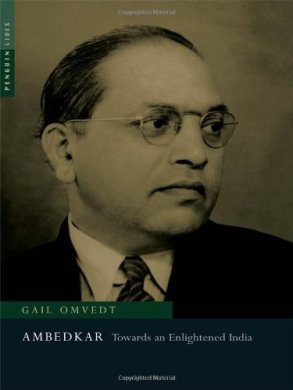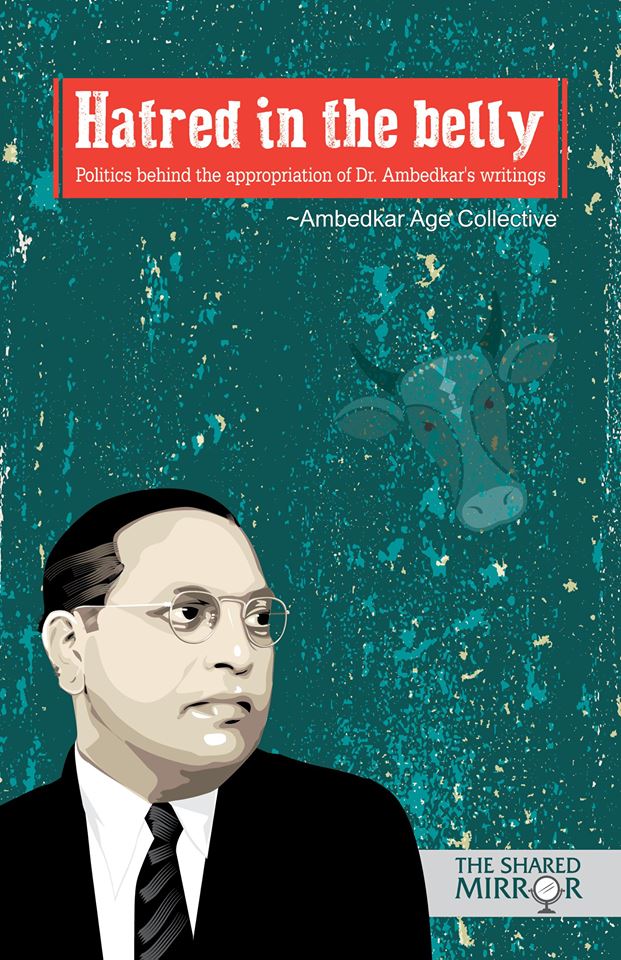Dalit activists and Ambedkarites had faced a lot of backlash from the Savarna media for their criticisms against the reprinting of Ambedkar’s Annihilation of Caste with an introduction by Arundhati Roy. The media went as far as to misrepresent them by equating them to right-wing goons. This book, Hatred in the Belly, is a collection of essays, speeches and status updates on social media that arose spontaneously in March after excerpts of Roy’s introduction were published in magazines such as Outlook, Caravan and the newspaper The Hindu. Decoding the response of Arundhati Roy to these criticisms (including an open letter by Dalit Camera) exposes her public image of a casteless, secular activist. Though these events may superficially be seen as dealing with only criticisms against Roy, S Anand, and their politics, it is really symbolic of the larger issue of appropriation of Dalit voices. This book represents a diverse group of people, from students, researchers, Dalit activists, writers, to entrepreneurs, etc. who have chosen to speak up from their social location, expertise, and activism. These writings were initially published in Round Table India, a digital media platform that caters to the Dalit, Bahujan and Adivasi majority of India. Now, as a published book, it has become an affirmation of resistance.
Roy is popularly quoted as saying “There’s really no such thing as the ‘voiceless’. There are only the deliberately silenced, or the preferably unheard.” It is amusingly unfortunate to now have the same words ring ironically over the elite writer. The event in question that sparked the debate is S Anand’s publication house ‘Navayana’ reprinting Ambedkar’s undelivered, ground-breaking speech titled Annihilation of Caste [AOC] with annotations and an introduction by Arundhati Roy. The introduction spans 180 pages, more than the actual text itself. The first obvious question raised was- Is this intervention to “re-introduce” Ambedkar even necessary? Ambedkar had first published this speech at his personal cost. Today, Dalit publishing houses and Dalits themselves have kept the book alive in their intellectual culture. The book was already available online for free. It is also cheaply available for around Rs. 45 as a hard copy. In contrast, this annotated version had cost Rs. 525 in its initial release. To add to the mockery, a closer look at the bibliography added to Roy’s introduction reveals that out of the 120 references, half of them are by Savarna authors and less than 15 are by Dalits. A similar pattern can be seen for the references and annotations to the text of AOC itself. In one of the essays in the book, writers James Michael and Akshay Pathak rightly call out S Anand and Roy over this issue as “they do not just appropriate a text, they Brahminise it.” (p. 159) Dalit scholarship is, therefore “deliberately silenced”.
A peculiar but interesting point is raised by Telugu poet and activist Joopaka Subhadra, who is also one of the contributors in this book. The most frequently seen pictures of Ambedkar evoke the aura of a calm, highly-educated man, dressed in western suits and adorning black-rimmed spectacles. Subhadra directs our attention to the picture chosen for Anand’s reprinted AOC’s book cover. She notes how this image of Ambedkar evokes helplessness, and she exclaims “You’ll understand what kind of hatred they nurse in their bellies when you look at this picture.” (p. 108)

Cover of Annotated version of AOC

Cover of Gail Omvedt’s biography of Ambedkar
Not only does the introduction do injustice to the history of the text and fail miserably to engage with the arguments of the text, it also shifts the reading of the text into a false Ambedkar versus Gandhi debate. There is so much to say about the context of the book, and also its contents. The Jat-Pat Todak Mandal (Society for the Abolition of Caste system), an anti-caste organisation based in Lahore, had invited Ambedkar to deliver a presidential address at its annual conference in 1936. After reading his speech beforehand, the organizers had insisted on deleting and diluting the contents of the text. Ambedkar had refused to even “change a comma”, which resulted in the withdrawal of his invitation. In AOC, Ambedkar speaks against not just the Hindu caste system, but he argues that to break the caste system, it was imperative to destroy the religious notions that it was built upon. Roy does not delve into these matters too deeply. Instead, there are many instances of misquoting and misrepresenting Ambedkar to frame her own arguments. She cherry-picks his quotes to portray him as pro-eugenics, concerned with the ‘civilising of Adivasis’ and equates his pro-modernity stance to his support for the current neoliberal state. Her focus shifts towards Gandhi and his legacy, and she projects herself as a sole thinker to have caught Gandhi’s bluff. Again, Roy is riding on the arguments that Dalit activists now, and Ambedkar then, have constantly been making in order to expose Gandhi’s hypocrisy. In one of the essays, PhD student Murali Shanmugavelan breaks down these unsubstantiated claims against Ambedkar, and articulately spots what Roy misses, that Gandhi, unlike Ambedkar, posed “no threat to western hegemony”. (p. 180)
Another presumption that Roy makes is that Gandhi’s shadow loomed over Ambedkar. Gee Imaan Semmalar, transman and self-professed Ambedkarite, shows how the inverse was true, where “Dr. Ambedkar thwarted Gandhi at every step, exposed him for the fraudulent reformer he was, led the biggest religious conversion in the history of the world, and gave even his enemies their constitutional and fundamental rights and much more.” (p. 151) Dalit Camera, a media organization that reports on Dalit and Adivasi issues through articles and videos on YouTube, wrote an open letter to Roy amidst the controversy. It had critiqued her minimal level of engagement with AOC, and clarified the stand of the many activists whose viewpoints had been distorted in the mainstream media which was jumping to her defence. It also enlisted 12 questions from various Dalit activists, asking her about the aim for writing this essay, enquiring about the scope for misreading Ambedkar in her introduction and questioning the ethicality in using Ambedkar as a platform to talk about Gandhi. In his essay, Semmalar also analyses Roy’s response to the questions of Dalit Camera. He points out that the self-proclaimed anti-imperialist crusader very consciously writes for a white audience. As part of her justification, she dilutes arguments against her act of appropriation with an arrogant suggestion that “more knowledgeable people should go ahead and write more introductions and that hers is just one among many” (p. 149). She wilfully overlooks how her cultural capital and social location helped her publish the introduction with so much pomp in the first place. While Roy reduces the valid arguments of Dalits over representation to an oversimplified matter of whether only Banias can write about Gandhi; Semmalar turns the tables on her as he asks why she didn’t make a comparative analysis that demystified Gandhi in an introduction to, say, Gandhi’s own book ‘Hind Swaraj’? (p. 146). Roy’s response to these criticisms are weak, haughty and reek of wilful ignorance. If there is one thing an “ally” is expected to do, it is to listen.
There are real consequences to the intellectual and cultural appropriation. It “others” the marginalized community. It trivializes not only the struggle of the oppressed but also the violence of the oppressor. The same things that Roy has spoken for the first time, and that too half-heartedly has been said many times over and in much better ways by Dalit thinkers. Her appropriation of Ambedkar does nothing to bring to light the Dalit struggle. Contributing editor of the Round Table India platform, Kuffir demonstrates how in central universities dominated by the Savarna faculty, Roy’s introduction will be used as a link to Ambedkar, as “they will segregate the original AOC from that book” (p. 73), which basically challenges nothing and reaffirms the Savarna world-view, even as it projects itself as ‘anti-Gandhi’. This real ramification of appropriation only helps prejudices persist. Joby Mathew, an ICSSR Doctoral fellow, brings to the fore Roy’s previous tryst with appropriation and her obsession with Gandhi. In her keynote address for the 150th birth anniversary of the social reformer Ayyankali, Roy had ‘preferably ignored’ the Dalit icon too. Roy’s agenda to pit Dalit revolutionaries with Gandhi limits the discourse over their legacies, and keeps bringing Gandhi forcefully, unnaturally into focus. Mathew also sees this strategy for its unoriginality, as he adds, “a person like Arundhati criticizes Gandhi by using the foundation created by Ambedkarite movements” (p. 201). Roy has been recycling the same arguments over and over again.
Another contributor in ‘Hatred in the Belly’ is the teacher and founder-editor of Insight Young Voices, Anoop Kumar who recognizes the marketing logic of Navayana for what it is- a messiah complex. With no hesitation, S Anand and Roy both proclaimed that their over-priced repackaging of AOC was not directed towards Dalits, but for the upper castes that are yet to read Ambedkar and the western academia “for whom caste is just some exotic Hindu thing” (p. 88). Kumar expresses his pain and contempt over the hypocrisy of this “generosity” that one is supposed to be grateful for, and silently, uncritically swallow. The messiah status that is also reinforced by her fans and the media nexus as it “…provide(s) you (Roy) so much space on issues they care two hoots about” (p. 114), the same space that “is so cruelly denied to us, is shut forever” (p. 113). It is no surprise that appropriation is often seen as unproblematic and harmless. However, in such instances, one can clearly see how a privileged person can be lauded for saying and doing the same thing that the community has been persecuted for. Roy profits from sensationalizing arguments that Dalit thinkers have been ostracised and silenced for. To accept the republication of AOC as a benevolence granted by the Savarna publishers as a means to give Western exposure to Dalit struggle belittles the very struggle.
This book, Hatred in the belly, delves deeply into the politics of appropriation. It deconstructs the title of Roy’s introduction with its symbolism of the doctor and the saint, beginning the text itself on a comparative note. It argues for readers to engage with the pain of the Dalit experience before talking about caste discrimination. It may very well be an instruction on what not to do if you call yourself an ally. In summary, the book successfully manages to connect various angles to the issue- the history of the Brahminisation of subaltern art and culture, the current realities of Dalit publishing and reading spaces, the critical analysis of Roy’s texts and S Anand’s unthoughtful anti-caste farce, and the very real implications on the lived reality of Dalits due to such appropriation. The diversity of the authors in this compilation is symbolic of the diversity within the struggle. The publication of the book is a victory in itself, and a fitting response to the active silencing that the Dalit activists have had to face by the Savarna elites in the media.
